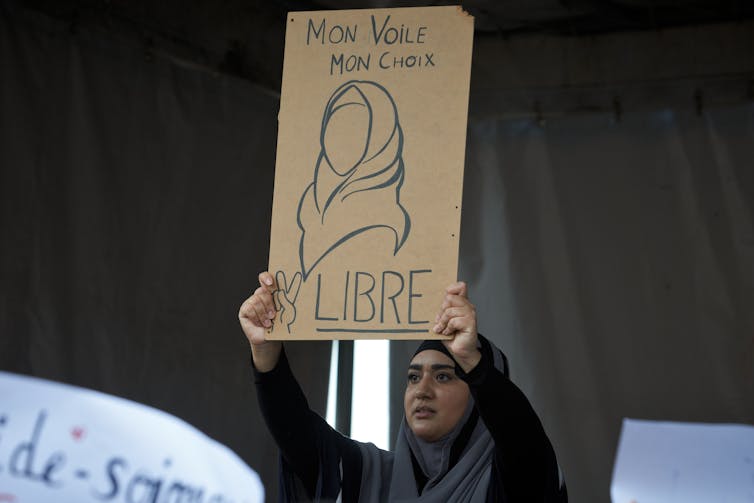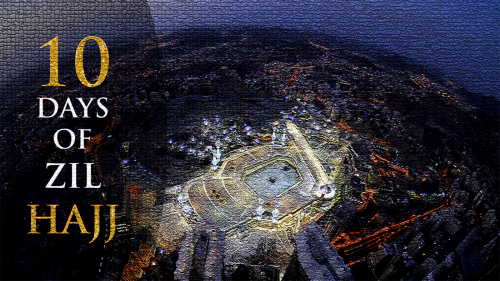Why Muslim Women Feel Empowered Wearing Hijab

Some Americans believe that the Islamic faith is oppressive for women. In the West, particularly in France, the hijab, or headscarf, that many Muslim women wear has become a symbol of this perceived oppression.
This article will explain some of the complex issues that go into many Muslim women’s choice to wear the hijab, including why some women see it as a mark of empowerment. It will also draw attention to some of the global Muslim feminist movements that often go unnoticed in the Western world.
Sociologist Caitlin Killian explains that Jewish, Christian and Hindu women have covered their heads since pre-Islamic days.
For some Muslim women today, wearing a hijab can be a religious act – a way of demonstrating their submission to God. The Quran instructs both men and women to observe modesty in their dress and behavior. However, Muslim women’s clothing isn’t entirely about adherence to faith. It has been used in the past – and present – as an assertion of identity.
Under colonial rule, Muslim women were encouraged to be more like European women and remove the veil. As demands for independence from colonial rule grew, the veil, Killian says, became a “symbol of national identity and opposition to the West.”

Today, some Muslim women in America may wear the hijab as a way of asserting their pride in the face of Islamophobia. World Hijab Day, celebrated on Feb. 1, starting in 2013, came about through the efforts of Nazma Khan, an immigrant to the United States from Bangladesh, who had been shamed over wearing a headscarf. She decided to start a day when both Muslim and non-Muslim women could experience wearing the head garment.
Even so, in much of the Western world, the headscarf continues to be seen as representative of Muslim women’s oppression. In Switzerland, voters approved legislation in March 2021 to ban face coverings, while France is pushing for a more restrictive policy on hijabs.
In a judgment on March 14, 2017, the Court of Justice of the European Union, which interprets EU law, allowed private companies in France to bar employees from wearing “religious, political and philosophical signs” in the interest of “neutrality.”

Sociologist Z. Fareen Parvez says the anti-headscarf legislation was a “turning point” in the lives of Muslim women looking for acceptance and integration in French society. The headscarf is not just a religious symbol for many of the women; it is a way of being.
But this focus on Muslim women’s clothing takes attention away from other issues and how Muslim feminist movements are trying to bring about change. In Indonesia, for example, female Muslim religious scholars, or ulamas, are helping change how Islam is understood and practiced.
As sociologist Rachel Rinaldo says, the past three decades in Indonesia have seen the emergence of a new generation of female religious leaders who are interpreting the Quran in a way that is empowering for women. The word of female ulamas is more accepted, compared to women’s rights activists, explains Rinaldo, as they are trained Islamic scholars.
A 2017 conference of female Muslim religious scholars held in Indonesia, with participants from Kenya, Pakistan and Saudi Arabia, issued fatwas – nonbinding religious edicts – against child marriage, sexual abuse and environmental destruction.
The point is that, like other faiths, Islam is a multifaceted religion, and Muslim women are choosing how they want to be heard and seen.
Fact: Female ulamas in Indonesia go back to the 17th century. Queen Tajul Alam Safiatuddin Syah ruled over the Islamic kingdom of Aceh (now Indonesia’s northernmost province) for 35 years and commissioned several important books of Islamic commentaries and theology. At a time when female rulers anywhere in the world were unusual, she was the primary upholder of religious authority in what was then a prosperous and peaceful kingdom (from an article written by Rachel Rinaldo, Professor of Sociology at the University of Colorado Boulder).
Further Readings and Resources:
- Why do Muslim women wear a hijab?
- How a growing number of Muslim women clerics are challenging traditional narratives
- EU court allows companies to ban headscarves. What will be the impact on Muslim women?
- “North African Women in France,” by Caitlin Killian. Sociologist Killian explores how Muslim women construct and manage their identities in a foreign culture.
- “Navigating Islam: The Hijab and the American Workplace,” by Fatima Koura, explores the lived experiences of 35 hijab-wearing Muslim-American women.![]()
The Conversation brings you a series of six articles that will explain Islam and its diversity and try to clear common misconceptions. They explore the history of American Muslims and gain a deeper understanding of their faith.
Kalpana Jain is the Senior Religion + Ethics Editor at The Conversation. She has worked as an editor, writer and researcher at Harvard University. She holds a Master in Theological Studies from Harvard Divinity School.
This article was reviewed by Jessica Marglin, Associate Professor of Religion at USC Dornsife College of Letters, Arts and Sciences.
( Source: This article is republished from The Conversation under a Creative Commons license. Read the original article. )
Topics: Hijab (Head Cover), Interfaith, Islamic Culture And Civilization, Muslims In The West, Understanding Islam
Views: 1783
Related Suggestions

















